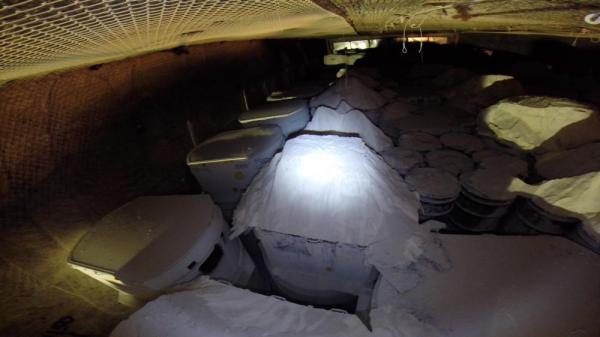First Kitty Litter, Now a Typo? Santa Fe New Mexican Investigates LANL Radiation Leak

Did a typo cause the $500 million (and counting) ongoing cleanup of the radiation leak at the Waste Isolation Project (WIPP) in Carlsbad, New Mexico? Or was the Los Alamos National Lab (LANL) rushing to ship all its Cold War era nuclear waste before a deadline so that it could secure an extension of its $2.2 billion annual contract from the U.S. Department of Energy (DOE)? The answer is: One begets the other.
In the months since the leak was discovered and the drama began unfolding on February 14 of this year, we have seen the blame shift from kitty litter to a lead-covered glove, and from the Waste Isolation Pilot Plant (WIPP, which stores it) to the Los Alamos National Laboratory (LANL, which packed and shipped it).
RELATED: Cause of WIPP Radiation Leak: Kitty Litter?
Radiation Leak Linked to Los Alamos; Do We Really Want Biological Agents There?
Now there has been yet another shift, according to a report in the Santa Fe New Mexican, which published the results of a six-month investigation into WIPP and LANL on November 16. The story shows that LANL not only made a series of mistakes early on, but also that when LANL officials found out, they were not forthcoming to the DOE, the state of New Mexico, the WIPP workers or the residents of Carlsbad.
RELATED: WIPP Radiation Leak Study Released; DOE Finds Probable Cause
The story cites an October 1 report by the DOE inspector general that says LANL and its contractors took shortcuts in treating the highly acidic nuclear waste. This is where the typo comes into play: when “inorganic” kitty litter (clay-based) became “organic” kitty litter (wheat-based). As LANL scientist Steve Clemmons said in a May 21 memo obtained by the Santa Fe New Mexican, the switch amounted to all the elements of a “plastic explosive” being put together into the drum that ruptured. When WIPP and DOE officials found out that the drums could “present a real and present danger,” they stopped plans to send in workers and test the area. After a back and forth between LANL, the DOE and WIPP the testing continued, but on June 17, LANL personnel on site at WIPP reported that the high-heat event may have compromised 55 other drums in the storage area, the Santa Fe New Mexican reported.
It took three months for the contents in the drum to react and cause what authorities have termed a “high-heat event,” another three months for LANL scientists to discover the “patented explosive” mixture, and then another week for the officials at WIPP to learn about it from LANL. The suspect drum—the entire shipment, in fact—should never have been allowed to be put on the truck, much less delivered and placed into storage at WIPP, the Santa Fe New Mexican found.
The November 16 story also blames the New Mexico Environment Department for failing to properly inspect waste drum shipments during LANL’s hurried cleanup to meet the June 30 deadline ahead of the fire season. The whole world saw a news helicopter video showing an outdoor area full of drums containing nuclear waste during the 2011 Las Conchas Fire. The $2.2 billion annual contract from DOE to LANL eventually became tied to meeting Governor Martinez’s June 30 deadline.
For the whole story, plus some LANL e-mails, photos and a history of the leak, read LANL Officials Downplayed Waste’s Dangers Even After Leak in the Santa Fe New Mexican.
Read more at http://indiancountrytodaymedianetwork.com/2014/11/24/first-kitty-litter-now-typo-santa-fe-new-mexican-investigates-lanl-radiation-leak-157985